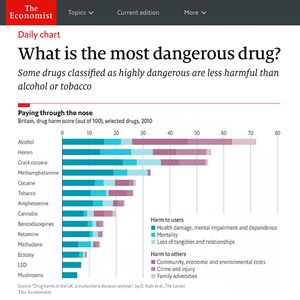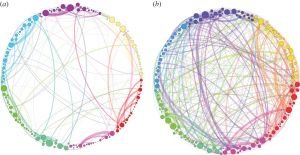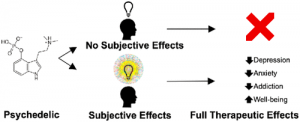Psychedelics: Difference between revisions
mNo edit summary |
|||
| Line 31: | Line 31: | ||
'''Dissociatives''' | '''Dissociatives''' | ||
* Ketamine a synthetic anaesthesia, which globally, is the most prescribed drug in this class. | * [[Ketamine]] a synthetic anaesthesia, which globally, is the most prescribed drug in this class. | ||
== Usage == | == Usage == | ||
| Line 55: | Line 55: | ||
''"MDMA experience reports featured an emotionally intensifying profile accompanied by many cognitive process words and dynamic-personal language. In contrast, Ayahuasca and DMT experience reports involved relatively little emotional language, few cognitive process words, increased analytical thinking-associated language, and the most semantic similarity with psychedelic and mystical experience descriptions<ref>'''Analysis of recreational psychedelic substance use experiences classified by substance.''' Adrian Hase, Max Erdmann, Verena Limbach & Gregor Hasler Psychopharmacology volume 239, pages643–659 (2022) Altmetric Metrics https://link.springer.com/article/10.1007/s00213-022-06062-3</ref>. LSD, psilocybin mushroom, and ketamine reports showed only small differences on the emotion-, analytical thinking-, psychedelic, and mystical experience-related language outcomes. Further research has concluded: “Both doses of LSD and the high dose of psilocybin produced qualitatively and quantitatively very similar subjective effects, indicating that alterations of mind that are induced by LSD and psilocybin do not differ beyond the effect duration”<ref name=":0" />.'' | ''"MDMA experience reports featured an emotionally intensifying profile accompanied by many cognitive process words and dynamic-personal language. In contrast, Ayahuasca and DMT experience reports involved relatively little emotional language, few cognitive process words, increased analytical thinking-associated language, and the most semantic similarity with psychedelic and mystical experience descriptions<ref>'''Analysis of recreational psychedelic substance use experiences classified by substance.''' Adrian Hase, Max Erdmann, Verena Limbach & Gregor Hasler Psychopharmacology volume 239, pages643–659 (2022) Altmetric Metrics https://link.springer.com/article/10.1007/s00213-022-06062-3</ref>. LSD, psilocybin mushroom, and ketamine reports showed only small differences on the emotion-, analytical thinking-, psychedelic, and mystical experience-related language outcomes. Further research has concluded: “Both doses of LSD and the high dose of psilocybin produced qualitatively and quantitatively very similar subjective effects, indicating that alterations of mind that are induced by LSD and psilocybin do not differ beyond the effect duration”<ref name=":0" />.'' | ||
For psilocybin, ketamine, mescaline and LSD it has been found that the psychedelic experience have yielded magnetoencephalographic (MEG) signals values exceeding those of normal waking consciousness. Indicating psychedelic drugs induce ‘''heightened state of consciousness''‘. The scans found the most notable effects in parts of the brain that are known to be important for perceptions, rather than other roles such as language and movement. | For [[psilocybin]], [[ketamine]], mescaline and LSD it has been found that the psychedelic experience have yielded magnetoencephalographic (MEG) signals values exceeding those of normal waking consciousness. Indicating psychedelic drugs induce ‘''heightened state of consciousness''‘. The scans found the most notable effects in parts of the brain that are known to be important for perceptions, rather than other roles such as language and movement. | ||
=== Medicinal Chemistry === | === Medicinal Chemistry === | ||
Revision as of 01:52, 6 December 2022
Psychedelics are medicinal compounds which affect the functioning of the human mind. Although historically psychedelics have been held in high regard, since the 1970's they have been shrouded in taboo. This was, in part, due to a US led criminalisation effort linked to preventing a decrease in conscription for the Vietnam War. However, since the advent of The Psychedelic Renaissance this fabrication is slowly dissipating. In the scientific community, psychedelics seen as neither good nor bad, but merely tools which have the unique property of inducing neuroplastic states.
During the psychedelic experience as shown in the brain scan to the right (Figure 1) subconscious inputs open up to the conscious mind effectively allowing the user to see the delusions and fallacies under the hood. Several peer reviewed studies have now shown that psychedelic use can lead to pronounced ecological concern[1][2][3][4][5][6]
Psychedelic Compounds
There are 5 classes of psychedelics based upon their effect and chemistry.
Tryptamines
- Psilocybin / psilocin found in magic mushrooms.
- DMT found in acacias and ayahuasca.
- 5-MeO-DMT found in toad venom.
Ergoline
- LSD derived from the rye fungus, ergot.
Phenylethylamines
- Mescaline found in the peyote cactus an Native American entheogen.
- MDMA and 2C-B synthetic compounds made by the chemist Alexander Shulgin.
Deliriants
- Muscimol found in the toadstool, amanita muscaria.
- Ibogaine, an African entheogen.
Dissociatives
- Ketamine a synthetic anaesthesia, which globally, is the most prescribed drug in this class.
Usage

Psychedelics are not without potential harm, however relative to alcohol and the majority of other drugs (See Figure 3) the risk is minimal. In a clinical sense, under specific priming and setting there is abundant evidence for the safety and efficacy for their use in the treatment of:
- Cyclical thought patterns:
- Depression - multiple meta analyses results suggest that psychedelic-assisted therapy is effective with minimal adverse effects[8][9], relative to a comparable meta analysis of the effects of 21 traditional antidepressant drugs[10], relative to other treatments psychedelics lack the majority of serious adverse effects.
- Obsessive compulsive disorder (OCD)
- Cyclical behavioural patterns:
- Ecological crisis denialism - there is a lot of data to suggest that the interconnectedness felt during the psychedelic experience can lead to pronounced ecological concern[4][5][6].
Numerous studies[13] and a systematic review[14] have concluded that guided psychedelic therapy can augment the above therapeutic effects.
Mechanism of Action
Psychedelics are exogenous neurotransmitters, that cause neuroplastic, pivotal mental states. It is thought psychedelics mediate this effect by altering Brain-Derived Neurotrophic Factor (BDNF)[15]
Psychedelic Comparison
Whilst the pharmaceutical industry markets that psychedelics can cure everything from obesity to hair loss, in reality there is little evidence that they can treat any other conditions apart from specific mental health issues. In this regard, the most commonly used psychedelics, Psilocybin, DMT and LSD have a very similar effect[16][17][18][19] whilst dissociatives are more Out of Body Experience orientated. Popular opinion suggests that each psychedelic irrelevant of class has an individual nuanced effect, this can be seen by the thousands of subjective reports scattered on the internet https://erowid.org/experiences/). However, a recent analysis of 2947 publicly available trip reports concluded:
"MDMA experience reports featured an emotionally intensifying profile accompanied by many cognitive process words and dynamic-personal language. In contrast, Ayahuasca and DMT experience reports involved relatively little emotional language, few cognitive process words, increased analytical thinking-associated language, and the most semantic similarity with psychedelic and mystical experience descriptions[20]. LSD, psilocybin mushroom, and ketamine reports showed only small differences on the emotion-, analytical thinking-, psychedelic, and mystical experience-related language outcomes. Further research has concluded: “Both doses of LSD and the high dose of psilocybin produced qualitatively and quantitatively very similar subjective effects, indicating that alterations of mind that are induced by LSD and psilocybin do not differ beyond the effect duration”[17].
For psilocybin, ketamine, mescaline and LSD it has been found that the psychedelic experience have yielded magnetoencephalographic (MEG) signals values exceeding those of normal waking consciousness. Indicating psychedelic drugs induce ‘heightened state of consciousness‘. The scans found the most notable effects in parts of the brain that are known to be important for perceptions, rather than other roles such as language and movement.
Medicinal Chemistry
All psychedelics are chemically unique and but can be catergorised into four main main types (see figure 2). There are three main families of chemical compounds: tryptamines, phenethylamines, or lysergamides and many tend to act via serotonin 2A receptor agonism which plays a key role in regulation of cortical function. Serotonin antagonism has been proposed as the mechanism for the subjective and biological effects of classical psychedelics as these effects are blocked after administering 5HT2AR antagonists such as ketanserin[21][22].
Side effects
Mescaline causes stomach cramps.
Duration of psychedelic state
- DMT: 30 minutes.
- Psilocybin: 3-6 hours.
- Ayahuasca 4-7 hours.
- LSD 6-11 hours.
- Mescaline: 8-15 hours.
Long lasting effect
Emotions and brain function are altered up to one month after a single high dose of psilocybin[23].
Psychedelic Contraindications
There are a few medicines and category of people which exclude patients from taking psychedelics:
- There is a theoretical interaction between SSRIs and psychedelics.
- There is some evidence to suggest olanzapine (an atypical antipsychotic) can terminate a trip[24].
- Kentanserin a research chemical and antagonist of 5-HT2A binds to the main psychedelic receptor but does not activate it. A recent study showed that giving participants kentanserin 1 hour after giving them LSD reduced the duration of LSD's subjective effects from around 8.5 hours to 3.5 hours[25]. In theory, kentanserin might have use for reducing or terminating a psychedelic experience.
- Presence or history of psychosis;
- Presence or history of mania or bipolar disorder;
Microdosing
The medical definition of microdosing is a dose given which is sub therapeutic, i.e. it is the dose doctors recognise as having no discernible effect. However, many claim, mainly via online survey studies, that very low doses of LSD, taken at 3–4-day intervals, improve mood and cognitive function[26].
In controlled studies, which in mental health are the gold standard, (see critical appraisal) the placebo effect is excluded. In all of these studies microdosing has been shown to have no effect[27] and even in some have shown negative effects such as neuroticism[28]. It has been suggested that this is because the experience of the trip is more important than the underlying chemical-electrical mechanisms[29] (see Figure 3) . By propagating the myth that microdosing does have an effect this may cause people from not accessing the correct dose and getting the actual benefit from the medicine.
Oneirogen
An oneirogen, is a substance or experience which enhances dream states, in effect this could be likened to an unconscious psychedelic states.
References
- ↑ Connectedness to Nature and to Humanity: their association and personality correlates. Front. Psychol., 21 July 2015. Sec. Personality and Social Psychology. Kibeom Lee, Michael C. Ashton, Julie Choi and Kayla Zachariassen. https://doi.org/10.3389/fpsyg.2015.01003. Accessed on 3rd October 2022 via https://www.frontiersin.org/articles/10.3389/fpsyg.2015.01003/full
- ↑ Increased nature relatedness and decreased authoritarian political views after psilocybin for treatment-resistant depression. Journal of Psychopharmacology. Taylor Lyons, Robin L Carhart-Harris. https://doi.org/10.1177/0269881117748902. Accessed on 3rd October 2022 via https://journals.sagepub.com/doi/full/10.1177/0269881117748902
- ↑ Psychedelics, Personality and Political Perspectives. Matthew M Nour 1, Lisa Evans 2, Robin L Carhart-Harris DOI: 10.1080/02791072.2017.1312643. 2017 Jul-Aug;49(3):182-191. doi: 10.1080/02791072.2017.1312643. Epub 2017 Apr 26. Accessed on 3rd October 2022 via https://pubmed.ncbi.nlm.nih.gov/28443703/
- ↑ 4.0 4.1 Manifesting Minds: A Review of Psychedelics in Science, Medicine, Sex, and Spirituality. Doblin, Rick; Brad Burge (2014) North Atlantic Books. ISBN 1583947272.
- ↑ 5.0 5.1 Lifetime experience with (classic) psychedelics predicts pro-environmental behavior through an increase in nature relatedness. Matthias Forstmann and Christina Sagioglou Journal of Psychopharmacology 2017. DOI: 10.1177/0269881117714049. Accessed on 30th September 2022 via: https://pubmed.ncbi.nlm.nih.gov/28631526/
- ↑ 6.0 6.1 From Egoism to Ecoism: Psychedelics Increase Nature Relatedness in a State-Mediated and Context-Dependent Manner. Hannes Kettner, Sam Gandy, Eline C. H. M. Haijen and Robin L. Carhart-Harris Centre for Psychedelic Research, Department of Brain Sciences, Faculty of Medicine, Imperial College London. International Journal of Environmental Research and Public Health. Published: December 2019 DOI: 10.3390/ijerph16245147. Accessed on 30th September 2022 via: https://pubmed.ncbi.nlm.nih.gov/31888300/
- ↑ https://www.economist.com/graphic-detail/2019/06/25/what-is-the-most-dangerous-drug
- ↑ Classic serotonergic psychedelics for mood and depressive symptoms: a meta-analysis of mood disorder patients and healthy participants. Nicole L. Galvão-Coelho, Psychopharmacology (Berl). 2021; 238(2): 341–354. Published online 2021 Jan 11. doi: 10.1007/s00213-020-05719-1. Accessed on 16th Spetember 2022 via https://www.ncbi.nlm.nih.gov/pmc/articles/PMC7826317/pdf/213_2020_Article_5719.pdf
- ↑ A Meta-Analysis of Placebo-Controlled Trials of Psychedelic-Assisted Therapy. Luoma, J. B., Chwyl, C., Bathje, G. J., Davis, A. K., & Lancelotta, R. (2020). Journal of Psychoactive Drugs, 1–11. doi:10.1080/02791072.2020.1769878. Accessed on 16th September 2022 via: https://pubmed.ncbi.nlm.nih.gov/32529966/
- ↑ Comparative efficacy and acceptability of 21 antidepressant drugs for the acute treatment of adults with major depressive disorder: a systematic review and network meta-analysis. Andrea Cipriani, MD. Published in the Lancet. February 21, 2018 DOI:https://doi.org/10.1016/S0140-6736(17)32802-7
- ↑ A Radical New Approach to Beating Addiction". Psychology Today. Retrieved February 24, 2019, also Francis Hartigan Bill Wilson p. 177-179.
- ↑ An online survey of tobacco smoking cessation associated with naturalistic psychedelic use. Journal of Psychopharmacology, 31(7), 841–850. Johnson, M. W., Garcia-Romeu, A., Johnson, P. S., & Griffiths, R. R. (2017). doi:10.1177/0269881116684335 10.1177/0269881116684335
- ↑ Psychedelic-Assisted Psychotherapy: A Paradigm Shift in Psychiatric Research and Development. Eduardo Ekman Schenberg. Front Pharmacol. 2018; 9: 733. Published online 2018 Jul 5. doi: 10.3389/fphar.2018.00733.
- ↑ A systematic review of psychedelic-assisted psychotherapy for mental health: An evaluation of the current wave of research and suggestions for the future. Wheeler, S. W., & Dyer, N. L. (2020). Psychology of Consciousness: Theory, Research, and Practice, 7(3), 279–315. https://doi.org/10.1037/cns0000237
- ↑ Psychedelics and Neuroplasticity: A Systematic Review Unraveling the Biological Underpinnings of Psychedelics Cato M. H. de Vos, Natasha L. Mason and Kim P. C. Kuypers* Department of Neuropsychology and Psychopharmacology, Faculty of Psychology and Neuroscience, Maastricht University, Maastricht, Netherlands Front. Psychiatry, 10 September 2021
- ↑ Effects of Naturalistic Psychedelic Use on Depression, Anxiety, and Well-Being: Associations With Patterns of Use, Reported Harms, and Transformative Mental States. Front. Psychiatry, 15 March 2022. Sec. Psychopharmacology. https://doi.org/10.3389/fpsyt.2022.831092
- ↑ 17.0 17.1 Direct comparison of the acute effects of lysergic acid diethylamide and psilocybin in a double-blind placebo-controlled study in healthy subjects. Holze, F., Ley, L., Müller, F. et al. Neuropsychopharmacol. 47, 1180–1187 (2022). https://doi.org/10.1038/s41386-022-01297-2
- ↑ Double-blind comparison of the two hallucinogens psilocybin and dextromethorphan: similarities and differences in subjective experiences. Carbonaro TM, Johnson MW, Hurwitz E, Griffiths RR. Psychopharmacology (Berl). 2018 Feb;235(2):521-534. doi: 10.1007/s00213-017-4769-4. Epub 2017 Nov 7. PMID: 29116367; PMCID: PMC6645364.
- ↑ Comparison of the Reactions Induced by Psilocybin and LSD-25 in Man. From the National Institute of Mental Health, Addiction Research Center, U. S. Public Health Service, Lexington, Kentucky by HARRIS ISBELL 1959
- ↑ Analysis of recreational psychedelic substance use experiences classified by substance. Adrian Hase, Max Erdmann, Verena Limbach & Gregor Hasler Psychopharmacology volume 239, pages643–659 (2022) Altmetric Metrics https://link.springer.com/article/10.1007/s00213-022-06062-3
- ↑ Preller KH, Herdener M, Pokorny T, Planzer A, Kraehenmann R, Stämpfli P, et al. The Fabric of Meaning and Subjective Effects in LSD-Induced States Depend on Serotonin 2A Receptor Activation. Curr Biol. 2017 Feb;27(3):451–7.
- ↑ Ly C, Greb AC, Cameron LP, Wong JM, Barragan EV, Wilson PC, et al. Psychedelics Promote Structural and Functional Neural Plasticity. Cell Rep. 2018 Jun 12;23(11):3170–82.
- ↑ Emotions and brain function are altered up to one month after a single high dose of psilocybin. Barrett, F.S., Doss, M.K., Sepeda, N.D. et al. Sci Rep 10, 2214 (2020). https://doi.org/10.1038/s41598-020-59282-y
- ↑ Olanzapine as the ideal “trip terminator”? Giuseppe Valeriani, Ornella Corazza, Francesco Saverio Bersani. First published: 28 July 2015 https://doi.org/10.1002/hup.2431. Accessed via: https://onlinelibrary.wiley.com/doi/10.1002/hup.2431
- ↑ Ketanserin reverses the acute response to LSD in a randomized, double-blind, placebo-controlled, crossover study in healthy subjects. Anna M Becker, Aaron Klaiber, Friederike Holze, Ioanna Istampoulouoglou, Urs Duthaler, Nimmy Varghese, Anne Eckert, Matthias E Liechti. International Journal of Neuropsychopharmacology, 2022;, pyac075, https://doi.org/10.1093/ijnp/pyac075
- ↑ Exploring the effect of microdosing psychedelics on creativity in an open-label natural setting. Prochazkova, L., Lippelt, D.P., Colzato, L.S. et al. Psychopharmacology 235, 3401–3413 (2018). https://doi.org/10.1007/s00213-018-5049-7
- ↑ Repeated low doses of LSD in healthy adults: A placebo-controlled, dose–response study Harriet de Wit,Hanna M. Molla,Anya Bershad,Michael Bremmer,Royce Lee First published: 01 February 2022 https://doi.org/10.1111/adb.13143https://onlinelibrary.wiley.com/doi/abs/10.1111/adb.13143
- ↑ A Systematic Study of Microdosing. Richard J. Stevenson, Macquarie University, Sydney, Australia. 10.1371/journal.pone.0211023
- ↑ The Subjective Effects of Psychedelics Are Necessary for Their Enduring Therapeutic Effects: David B. Yaden and Roland R. Griffiths* ACS Pharmacol. Transl. Sci. 2021, 4, 2, 568–572. Publication Date:December 10, 2020. https://doi.org/10.1021/acsptsci.0c00194


